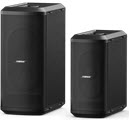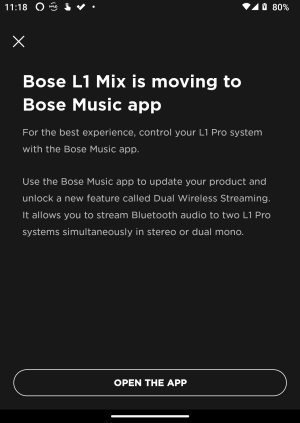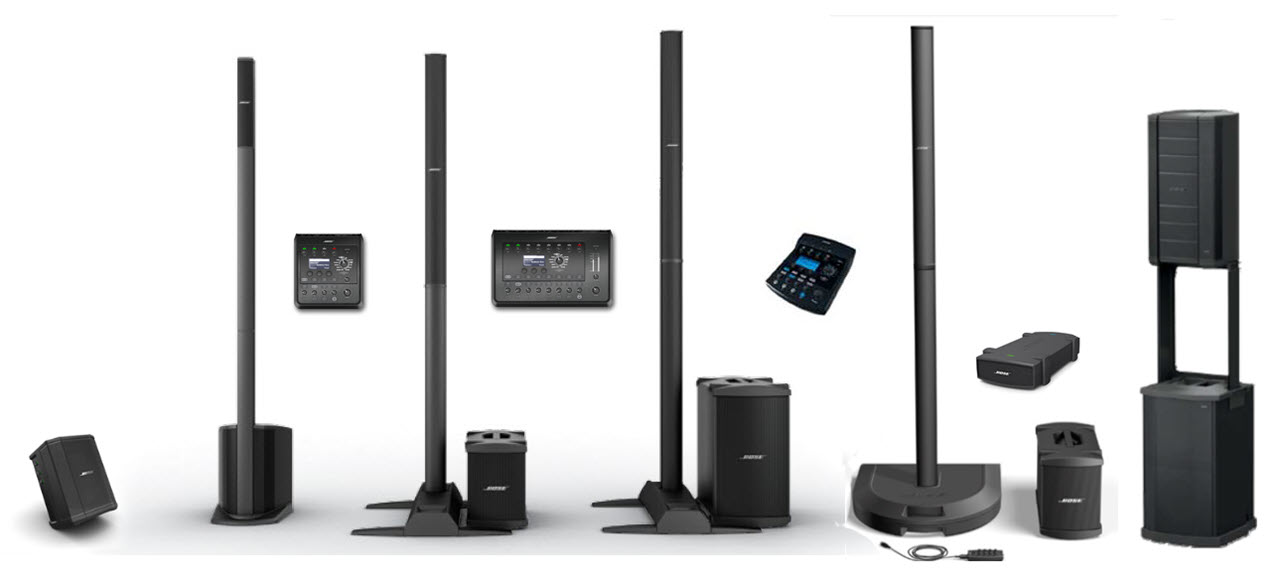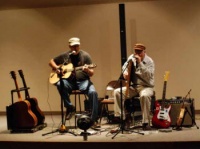Difference between revisions of "The Bose Professional Portable PA Encyclopedia"
m |
m |
||
| Line 190: | Line 190: | ||
---- | ---- | ||
| − | + | <!-- | |
This site is running wiki software by MediaWiki (see logo at bottom right of the page). If it looks familiar, it is because it is the same software used by millions of people on [http://wikipedia.com Wikipedia]. | This site is running wiki software by MediaWiki (see logo at bottom right of the page). If it looks familiar, it is because it is the same software used by millions of people on [http://wikipedia.com Wikipedia]. | ||
| − | + | --> | |
<br> | <br> | ||
Revision as of 23:49, 20 May 2021
FAQs about the Bose Portable PA family of products.
Watch this space for exciting new articles about a different family of products.
Contents
- 1 L1 Pro Family
- 2 Sub1/Sub2
- 3 Bose Music App / L1 Mix App
- 4 ToneMatch Mixers
- 5 Other Bose Portable PA Products
- 6 Earlier Products
- 7 Product Articles
- 8 Frequently Asked Questions
- 9 Articles by Application
- 10 New Articles
- 11 Legacy System Updates
- 12 Product Announcements
- 13 Identify your L1®
- 14 Unofficial Guides & FAQs for Bose Professional Portable
- 15 Education
- 16 Getting Started
- 17 Vision
- 18 Mission
- 19 Goals
- 20 Related Reading
The L1 Pro models share a common user interface and the L1 Mix app. This page has links to resources for all three models and the Bose products that integrate with them.
L1 Pro Family
Bose Pro announced the Bose L1 Pro line, October 26, 2020.
Documentation
L1 Pro8
L1 Pro16
L1 Pro32
Sub1/Sub2
L1 Pro Technical Data Sheets
- L1 Pro8 Technical Data Sheet
- L1 Pro16 Technical Data Sheet
- L1 Pro32 Technical Data Sheet
- Sub1 Technical Data Sheet
- Sub2 Technical Data Sheet
L1 Pro Self-Serve Support
Application Guide
L1 Pro Firmware
Resources
L1 Pro Family Selection Guide (product comparison)
Choosing the L1 Pro System That's Right for You (Youtube) / (Facebook livecast)
Bose L1 Pro Technical Training Videos
L1 Pro and the Mobile DJ - video
Bose Pro Portable PA Community
L1 Pro Technical Certification Course (no charge, but you must register)
Articles
Should I get an L1 Pro8 or L1 Pro16?
Should I get an L1 Pro16 or L1 Pro32?
Do I Need to Upgrade from the L1 Compact to the L1 Pro8?
Do I Need to Upgrade from the L1 Model II to the L1 Pro32?
S1 Pro+ x 2 vs L1 Pro8 with T4S
Which L1 Pro for Singer/Songwriter/Electric Guitarist
T1 Compatibility With L1 Pro Systems
L1 Pro and SimpleSync Connect L1 Pro to Bose Smart Speaker Group
L1 Pro32 Separating the Sections of the Mid-High Array
Comparing Specifications
Comparing L1 Pro Models
Bose L1 Pro8 Compared to L1 Pro16
Bose L1 Pro16 Compared to L1 Pro32
Comparing L1 Pro Power Stands to Subs
Legacy to L1 Pro Models
Bose L1 Compact Compared to L1 Pro8
Bose L1 Model 1S Compared to L1 Pro16
Bose L1 Model II Compared to L1 Pro32
Quick Tips
L1 Pro Line Out
The XLR Line Output from any L1 Pro contains the sound from all inputs (1, 2, 3, Bluetooth, and ToneMatch Port). That includes
- ToneMatch Presets
- Tone Controls
- Reverb
- The signal from a ToneMatch mixer connected to the ToneMatch port including ToneMatch Presets, zEQ, Reverb, Effects.
The sound is NOT affected by the L1 Pro System EQ setting.
L1 Pro Daisy Chain
Want to connect one or more L1 Pro systems together? See L1 Pro Daisy Chain
L1 Pro System EQ
The System EQ feature on the L1 Pro systems applies an EQ preset to the master output. This is similar to a graphic equalizer on traditional analogue mixers, but it uses four presets instead for quick access. read more — L1 Pro System EQ
L1 Pro32 Half Stack
- Can I operate the L1 Pro32 with only the lower section of the line array?
- Sometimes there is not sufficient height to use the full array
- Yes
- The L1 Pro32 can be used without the upper array. This configuration is useful when a venue ceiling cannot accommodate the height of the L1 Pro32
Source: Page 7 of the L1 Pro32 Owners Guide
- For best results, ensure array is at ear level for listeners
- Unlike the L1 Model II, the L1 Pro32 automatically adjusts the level of the bass output to maintain the appropriate spectral balance.
- It’s a valid use case to use only the bottom array section. In fact, the EQ automatically adjusts to compensate.
Craig Small - Bose
- Half Stack Not Recommended for Small Gigs
Running only the lower section of the Line Array is a workaround when there isn't enough ceiling clearance to use both sections. For small gigs, turn down the volume on the L1 Pro32, don't run without the top section of the array because
- You'll need to elevate the system so the array is at ear level for the audience. Otherwise, the sound will be muffled
- You will reduce your projection over distance. The sound will drop off more over distance.
- You may need to turn up the volume louder than if you were using the full array. As a result, you increase the likelihood of feedback.
FAQ
- Q
- What are the mid-high array and lower mid-high array made from? Metal mesh front and is rear metal or plastic?
- A
- Arrays on all units feature an extruded aluminum sleeve. Perforated grille on the front, solid on the back. Source: Craig Small
- Q
- Are the column speaker arrays interchangeable between the different models? (L1 Pro8, L1 Pro16, L1 Pro32)
- A
- No. While the column arrays and extensions of the L1 Pro8 and L1 Pro16 will fit each other, no sound comes out.
Sub1/Sub2
Bose Music App / L1 Mix App
- March 2023 - The L1 Mix App is replaced by the Bose Music App
- Note: If you currently use the L1 Mix App, you may see a message that says to switch to the Bose Mix App. If you're not ready to do that (e.g., you're at a gig), tap the X to dismiss the message so you can continue with the L1 Mix App.
Firmware version 3.0.0 is required to use the new app.
For more details about the firmware update see: L1 Pro Firmware
- Introduction to the Bose Music App
It's L1 Pro control in your pocket. With the Bose Music app, you can access intuitive, wireless control of your Bose L1 Pro portable PA system.
Tip
Run your finger up and down over the dials (as though they were sliders). Don't try to follow the curve.
ToneMatch Mixers
Engineered with a powerful DSP engine and intuitive user control, the T4S/T8S ToneMatch mixers offer studio-quality EQ, dynamics and effects. Sound great with integrated BoseToneMatch processing and zEQ, especially when connected to a Bose L1 or F1 system for full end-to-end tonal control.
read more — T4S/T8S ToneMatch® Mixers
Other Bose Portable PA Products
Unofficial Guides & FAQs for Bose Professional Portable
This is the home of Unofficial [1] Guides for Bose F1 and L1 System Users and Performers.
- Users Guide - Owner contributed knowledge
- Performers Guide - Quick Start for Non-Owners
- Different Models (What do I have?)
 Downloads ← New owners - make sure your equipment is up to date!
Downloads ← New owners - make sure your equipment is up to date!- Application Notes (Solo, Duo, Ensemble, DJ, Jam Session and more)
- The Sketcher Stage layout tool
Education
- Playing Better with the L1® system - Cliff Goodwin
- Interactive Tools Experience the gear online
- Video presentations Learn about your L1® and view interviews and tutorials from People-at-Bose and Community Experts.
- Common Terms and Acronyms
- Reference Articles
- Application Notes based on how you use the L1®: Solo, Duo, DJ
- Musical Instruments
- General Interest Articles for L1® System users.
- Acoustic Guitar Tone & the L1® - Featured article from Tom Munch
L1® Systems on Tour
Please follow the link and then view it full screen.
Getting Started
- Click the links in the menu at the top left.
- Try the search box (just type in a keyword that comes up in the forum and click Search). Terms to try (individual words) Gain Mixer Mono Phase Chris Cliff Hilmar (hint: you can double click a keyword and drag it into the search box. Then click Search).
- Try the Random page link (just keep clicking it for a fast trip around the wiki). After you try it once, you can use the link in the top left menu keep going.
On most pages, you will see category links across the bottom. You can try those too.
Vision
To help Musicians to deliver their music to their audiences with the grace and ease that comes of knowing their craft and their tools.
Mission
To share our collective and growing knowledge about the L1 technology so that we all spend less time thinking about the technology, and more time playing Music.
Goals
- To change the perception of Live Music.
- To make it possible for musicians to take their music and share it with their audiences, contributing recognizable value and being fairly compensated for what they contribute.
Related Reading
The Bose L1® Wiki Project - For background about the project
Wikipedia:Replies to Common Objections
Original Source adapted for this site below
See Project:Copyrights for more information.
Bose Portable PA Encyclopedia at http://toonz.ca/bose/wiki/ is the online home of and an access point for information about the Bose Portable PA products (L1, F1, S1).
Information Sources
Most of the information here has been supplied by or reviewed by Bose Corporation. External links to technical and marketing data are direct to the Bose site wherever possible.
Editorials and personal opinions are clearly marked.
No contract; limited license
Please make sure that you understand that the information provided here is being provided freely, and that no kind of agreement or contract is created between you and the owners or users of this site, the owners of the servers upon which it is housed, the individual Bose Portable PA Encyclopedia contributors, any project administrators, sysops or anyone else who is in any way connected with this project or sister projects subject to your claims against them directly. You are being granted a limited license to copy anything from this site; it does not create or imply any contractual or extracontractual liability on the part of MediaWiki or any of its agents, members, organizers or other users.
There is no agreement or understanding between you and Bose Portable PA Encyclopedia regarding your use or modification of this information beyond the GNU Free Documentation License (GFDL); neither is anyone at Bose Portable PA Encyclopedia responsible should someone change, edit, modify or remove any information that you may post on Bose Portable PA Encyclopedia or any of its associated projects.
Trademarks
Any of the trademarks, service marks, collective marks, design rights, personality rights or similar rights that are mentioned, used or cited in the articles of MediaWiki.org are the property of their respective owners. Their use here does not imply that you may use them for any other purpose other than for the same or a similar informational use as contemplated by the original authors of these Bose Portable PA Encyclopedia articles under the GFDL licensing scheme. Unless otherwise stated Bose Portable PA Encyclopedia and Bose Portable PA Encyclopedia sites are neither endorsed nor affiliated with any of the holders of any such rights and as such Bose Portable PA Encyclopedia can not grant any rights to use any otherwise protected materials. Your use of any such or similar incorporeal property is at your own risk.
Jurisdiction and legality of content
Publication of information found on MediaWiki.org may be in violation of the laws of the country or jurisdiction from where you are viewing this information. The Bose Portable PA Encyclopedia database is stored on a server in the Province of British Columbia in Canada, and is maintained in reference to the protections afforded under local and federal law. Laws in your country or jurisdiction may not protect or allow the same kinds of speech or distribution. Bose Portable PA Encyclopedia does not encourage the violation of any laws; and cannot be responsible for any violations of such laws, should you link to this domain or use, reproduce, or republish the information contained herein.
Thank you for spending the time to read this page, and please enjoy your experience at Bose Portable PA Encyclopedia. span class="structuredData">
Overview of this site
- Users Guide - Owner contributed knowledge
- Performers Guide - Quick Start for Non-Owners
- Different Models (What do I have?)
 Downloads ← New owners - make sure your equipment is up to date!
Downloads ← New owners - make sure your equipment is up to date!- Application Notes (Solo, Duo, Ensemble, DJ, Jam Session and more)
- The Sketcher Stage layout tool
Bose L1® Model II
URL http://worldwide.bose.com/pro/en_us/web/l1_model2/page.html
Release Date: 2007-03-29
Height: 84 inches
Weight: 84 pounds (includes B1)
Power Stand Depth:27.2 inches
Power Stand Width:26 inches
Description: FAQ, documentation, hints and tips for owners of the L1® Model II
Description:
Key Features
High-performing, powered, portable two-way loudspeaker system with a 195° H x 0° V nominal dispersion designed for the production and reproduction of live music, music playback, speeches and A/V sound reproduction
24-driver articulated line array loudspeaker technology produces wide, uniform sound coverage throughout the entire listening area—even off to the extreme sides
Consistent front-to-back coverage, 24 drivers mounted in a vertical line array produce little drop in sound pressure level per doubling in distance than a conventional point source
Retractable folding leg mechanism for easy transport
Lightweight, interlocking components
Expandable bass design supports the use of multiple B1 bass modules or a single B2 bass module
Digital Ethercon port provides single-wire connectivity for the T1 ToneMatch audio engine
Physical
Enclosure
Power Stand: Polypropylene cover with cast aluminum legs and steel chassis base
Cylindrical Radiator: Aluminum enclosuure with ABS baffle
Dimensions
Assembled height: 84.0" (2134 mm)
Net Weight
Power Stand: 23.7 lb (10.7 kg)
Cylindrical Radiators (pair): 33.7 lb (15.3 kg)
B1 bass module: 26.6 lb (12.1 kg)
B2 bass module: 45 lb (20.41 kg)
Color
Black
Package Contents
1 system
Bose L1® Model I
URL http://worldwide.bose.com/pro/en_us/web/l1_model1/page.html
Release Date: 2007-03-29
Height: 82.5 inches
Weight: 97 pounds (includes B1)
Power Stand Depth:26 inches
Power Stand Width:26 inches
Description: Bose Spatial Dispersion™ system technology delivers sound evenly across the stage and throughout the audience. The L1 Model I and L1 Model II systems project sound waves forward and to the sides at nearly 180 degrees and with little vertical dispersion, reducing unwanted room reverberation. Amplified sound is spread more evenly across the stage and into the audience. The volume level drops off much more slowly than with a conventional speaker.
Description: High-performing, powered, portable two-way loudspeaker system with a 160° H x 0° V nominal dispersion designed for the production and reproduction of live music, music playback, speeches and A/V sound reproduction
Spatial Dispersion™ loudspeaker technology produces wide, uniform sound coverage throughout the entire listening area—even off to the extreme sides
Consistent front-to-back coverage, 24 drivers mounted in a vertical line array design produce a loss of only 3 dB in sound pressure level per doubling in distance
Integrated ToneMatch® presets for popular vocal microphones and instruments
Integrated 4-channel mixer with wired remote control
Lightweight, interlocking components for easy transport
Expandable bass design supports the use of multiple B1 bass modules
Bose L1® T1 ToneMatch® Audio Engine
URL [/bose/wiki/images/5/58/T1-185.png /bose/wiki/images/5/58/T1-185.png ]
Release Date: 2007-03-29
Height: inches
Weight: 2.1 pounds
dimensions 8.22" H x 6.52" W x 2.66" D (209 mm H x 165 mm W x 67 mm D)
Power Stand Depth:n/a
Power Stand Width:n/a
Description: FAQ, documentation, hints and tips for owners of the T1 ToneMatch® Audio Engine
Description: T1 ToneMatch® Audio Engine
Features
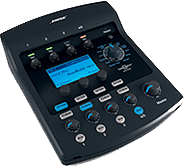
Technical Specifications
Audio Channels
4
Outputs
2- Master and AUX
A/D and D/A Converters
24-bit
Sample Rate
48 kHz
USB & Interfaces
1.1 protocol, Type A to Type B cable
Dimensions
8.22" H x 6.52" W x 2.66" D (209 mm H x 165 mm W x 67 mm D)
Shipping Weight
2.1 lb (.97 kg)
The T1 ToneMatch® audio engine is a digital multichannel mixer designed for use with Bose® L1® sound systems. It provides four independent channels, over 100 proprietary ToneMatch presets for instruments and microphones and a complete suite of studio-class effects and sound processors.
Proprietary ToneMatch presets optimize L1 system to match the intended natural sound of specific instruments and vocal mics. Over 100 presets are organized into quick-access banks and can be independently assigned to each channel. Free ongoing updates can be downloaded via a USB connection between your computer and the ToneMatch audio engine.
More than 100 proprietary ToneMatch presets for a variety of popular microphones and instruments
Four input channels with independent selection of ToneMatch presets and effects
Proprietary zEQ for precise tone control, plus a complete suite of studio-class effects and processing, such as reverb, delay and modulation
Chromatic tuner
Phantom power
Compatible with any L1 system
(requires T1 power supply for use with L1 Model 1 and L1 Compact systems, and with a PC)
User interface

Input signal/clip LEDs (1-4/5) — Displays the input signal status in color: Green indicates the presence of an input signal, yellow indicates a signal near clipping and red indicates clipping
Trim controls (1-4/5) — Adjust the input sensitivity for the respective channel
Phantom power switch — Applies +48V power to input channels 1-3. A red LED indicates that phantom power is on
Display — Provides function menus and system status information
T1 rotary selector — Allows access to both global and channel related parameters, which are adjusted using the editing controls
Editing controls — These three rotary/push-button controls allow you to select or adjust items/values appearing on the display
CH edit buttons (1-4/5) — Select the channel you want to modify using the T1 rotary selector and display-related editing controls
FX mute buttons (1-4/5) — Bypass the Mod, Delay and Reverb effects on the selected channel
Volume controls (1-4/5) — Adjust the volume level for the respective channel
Mute buttons (1-4/5) — Silence the audio output for the respective channel
MASTER volume control — Adjusts the overall output level
Inputs and Outputs
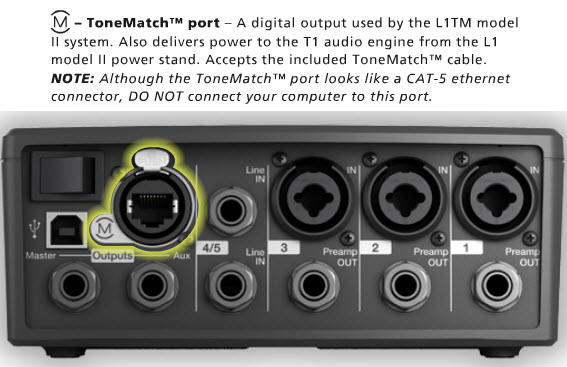
ToneMatch port — A digital output used by the L1 Model 1S and Model II systems. Also delivers power to the T1 audio engine from the L1 Model 1S and Model II power stands. Accepts the included ToneMatch cable
Power switch — Turns the T1 audio engine on or off
IN — Analog input channels 1-3. Accepts XLR balanced cables for microphones, or ¼" TRS balanced or TS unbalanced cables for high-impedance inputs such as guitars
USB port — A USB interface that allows you to connect the T1 to your computer. This feature enables you to stream audio to/from your computer, update the T1 and back up performance scenes
Preamp OUT — Preamp outputs for channels 1-3. Accepts ¼" TRS balanced or TS unbalanced cables
Master output — User-definable analog output. Can be configured for a pre- or post-master volume analog output. Accepts ¼" TRS balanced or TS unbalanced cables
Aux output — User-definable analog output. Can be configured for a pre-fader, post-EQ, and effects or post fader output. Accepts ¼" TRS balanced or TS unbalanced cables
Line IN — Analog input channels 4/5. Accepts ¼" TRS balanced or TS unbalanced cables for line-level inputs. Can be used for stereo input signals
Bose L1® Compact
URL http://worldwide.bose.com/pro/en_us/web/l1_compact/page.html
Release Date: 2012-09-27
Height: 78.5 inches
Weight: 29.2 pounds
Power Stand Depth:16.8 inches
Power Stand Width:13.2 inches
Description: FAQ, documentation, hints and tips for owners of the L1® Comppact
Description:
Key Features
High-performing, powered, portable two-way loudspeaker system with a 180° H x 40° V nominal dispersion designed for the production and reproduction of live music, music playback, speeches and A/V sound reproduction
Articulated line array loudspeaker technology produces wide, uniform sound coverage throughout the entire listening area—even off to the extreme sides
Curved array design provides 40° of vertical coverage
Integrated ToneMatch® presets contain hardwired equalization curves for dynamic handheld microphones and acoustic guitars
Lightweight, interlocking components for easy transport
Offers both collapsed and extended setup positions
Physical
Enclosure
Power Stand: Polypropylene
Extensions and Array: ABS
Dimensions
Assembled height, collapsed position: 16.5" (418 mm)
Assembled height, extended position: 78.5" (1995 mm)
Net Weight
Power Stand: 24.6 lb (11.2 kg)
Extensions (each): 2.3 lb (1.1 kg)
Color
Black
Package Contents
1 system
Bose L1® B2 Bass Module
URL https://pro.bose.com/en_us/products/loudspeakers/portable/portable_accessories/b2_bass_module_acc.html#v=b2_bass_module_acc_black
Release Date: 2012-09-27
Height: 23.4 inches
Weight: 45 pounds
dimensions 23.4H x 13.31W x 18.9D (59.4 cm x 33.8 cm x 48 cm)
Power Stand Depth:18.9 inches
Power Stand Width:13.31 inches
Description: FAQ, documentation, hints and tips for owners of the Bose B2 Bass Module
Description:
- High-performance flexible bass module
- Designed to provide deep, impactful bass for higher SPL live music and DJ applications
- Features two 10" high-excursion woofers mounted in a rugged enclosure
- Features a three-position sensing switch, allowing bass output to be adjusted for different applications
- Interlocking end caps allow up to two B2 modules to be stacked together
- Includes a slip cover and NL4 cable
[edit] Electrical Specifications
- Impedance: 4 ohms
- When used with Model 1S or Model II
- Frequency Response (+/-3 dB) 40Hz - 200 Hz
- Frequency Range (-10 dB) 32 Hz - 200 Hz
- When used with Model / Classic
- Frequency Response (+/-3 dB) 40 Hz - 180 Hz
- Frequency Range (-10 dB) 32 Hz - 180 Hz
[edit] Mechanical Specifications
Dimensions: 23.4H x 13.31W x 18.9D (59.4 cm x 33.8 cm x 48 cm)
Weight: 45 lb (20.41 kg)
- ↑ This site is privately owned, supported by volunteer efforts of owners of the F1 and Bose® Personalized Amplification System™ family of products of products. Please see About Bose Portable PA Encyclopedia for more information.



